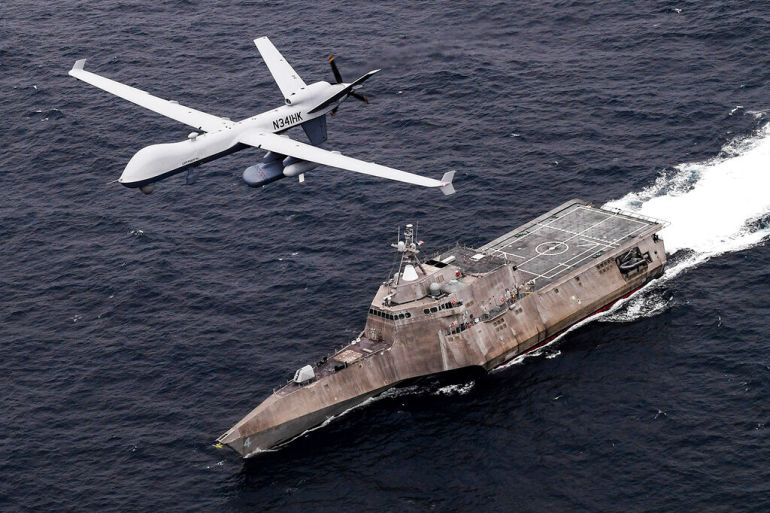US air wars in Middle East ‘deeply flawed’: Report
US’s air wars in Middle East marked by ‘flawed intelligence’ and ‘faulty targeting’ that led to hundreds of civilian deaths, NYT investigation finds.

Newly obtained Pentagon documents show the United States’ air wars in the Middle East have been marked by “deeply flawed intelligence” and “faulty targeting” that resulted in the deaths of more than 1,000 civilians over the last decade, according to a New York Times investigation.
The report, based on a trove of confidential Pentagon documents covering more than 1,300 reports of civilian casualties, undercuts the US government’s portrayal of a war fought with precision bombs, the publication said.
Keep reading
list of 3 itemsNo misconduct in deadly US drone attack in Kabul: Pentagon review
Drone exposé: The journalism that forced the Pentagon’s mea culpa
Pledges of transparency and accountability, it said, had regularly fallen short.
“Not a single record provided includes a finding of wrongdoing or disciplinary action,” the newspaper reported in what it said was the first of a two-part series.
While several of the cases mentioned by the Times have been previously reported, it said its investigation showed that the number of civilian deaths had been “drastically undercounted,” by at least several hundred.
Surveillance flaws
In its report, the New York Times reviewed cases in which civilians were killed, none of which resulted in an admission of wrongdoing.
It mentioned the killing of 120 Syrian villagers on the outskirts of the village of Tokhar, in a July 2016 strike that reports at the time said had killed 85 fighters.
Another example came in the implementation of an air raid in November 2015 in the Ramadi region in Iraq, after a person was observed dragging an “unidentified and heavy object” to an ISIS (ISIL) site. It was found in a report prepared after a review that the object was a child who died in the raid.
Poor or inadequate surveillance footage often contributed to deadly targeting failures, the report said.
Most recently, the US was forced to retract allegations that a car that was destroyed by a drone on a street in the capital of Afghanistan, Kabul, in August was loaded with bombs.
It was later revealed that the victims of the strike were 10 members of one family.
Many civilian survivors of US attacks, the report says, were left with disabilities requiring expensive treatment, but condolence payments numbered fewer than a dozen.
Asked for comment, Captain Bill Urban, spokesman for the US Central Command, told the Times that “even with the best technology in the world, mistakes do happen, whether based on incomplete information or misinterpretation of the information available. And we try to learn from those mistakes.
“We work diligently to avoid such harm. We investigate each credible instance. And we regret each loss of innocent life.”
Unseen from the air
The US air campaign in the Middle East grew rapidly in the final years of former President Barack Obama’s administration, as public support waned for ground wars.
Obama said the new approach, often using unmanned aircraft controlled from far away, represented “the most precise air campaign in history,” able to keep civilian deaths to a minimum.
The new technology made it possible to destroy a part of a house filled with enemy fighters while leaving the rest of the structure standing, the Pentagon said.
But over a five-year period, US forces carried out more than 50,000 air strikes in Afghanistan, Iraq and Syria, the report said, with far less than the advertised precision.
In compiling its report, the Times said its reporters had “visited more than 100 casualty sites and interviewed scores of surviving residents and current and former American officials”.
The paper obtained the Pentagon documents through Freedom of Information requests beginning in March 2017 and lawsuits filed against the Defense Department and the Central Command. A new suit seeks records from Afghanistan.
Before launching air strikes, the US military must navigate elaborate protocols to estimate and minimise civilian deaths.
But there are several ways available intelligence can mislead, fall short, or at times lead to disastrous errors.
For example, the Times said, video shot from the air does not show people in buildings, under foliage or under tarpaulins or aluminium covers.
And available data can be misinterpreted, as when people running to a fresh bombing site are assumed to be fighters, not would-be rescuers.
Sometimes, the Times said, “Men on motorcycles moving ‘in formation,’ displaying the ‘signature’ of an imminent attack, were just men on motorcycles.”
Urban, the Central Command spokesman, said air-war planners do their best under exceedingly difficult conditions.
But he added that “in many combat situations, where targeteers face credible threat streams and do not have the luxury of time, the fog of war can lead to decisions that tragically result in civilian harm”.